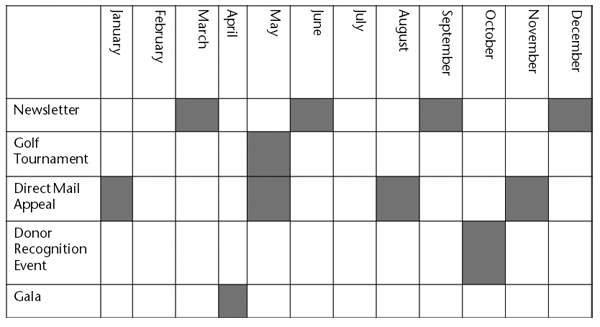Strategy—A plan of action, esp. for attaining a goal
Communication—The exchange of ideas, messages, or information
Strategic Communications means using organizational communications to create, strengthen or preserve, among key audiences, opinion favorable to the attainment of organizational goals
Reality Check
There are over 1.3 million nonprofits in the United States
Marketing strategies are dynamic and interactive.
They are partially planned and partially unplanned.
We have natural disasters, economic factors, new technological advancements, new competitors.
Strategic Planning looks beyond the immediate circumstances, the process clarifies where you want to be in the future.
But remember, we are were we are today because of the things that we did yesterday.
What should we know about Ourselves?
Estimated business strength
Market share
Financial strengths and weaknesses
Profitability
Quality of management
Technology position
Marketing strategy (Target market, program positioning)
What Should we know about our Donors?
Estimated annual donations
Projected annual growth rates
How many donors do we have
Demographic/Socioeconomics of donors
Geographic concentration or dispersion
Donor giving motives
Information they base decisions on
Charity practices
What should we know about our Competitors?
Strengths
Market share
Financial strengths and weaknesses
Donor Likes and Dislikes
Quality of management
Marketing strategy (Target market, program positioning, and strategy)
Types of Marketing Collateral
Brochures
Business Cards
Fliers
Slip Sheets/Buck Slips
Direct Mail Pieces
Letters
Catalogues
Annual Reports
What is the specific goal for the piece?
Gain revenue?
Educate?
Generate Leads?
Internal Communication?
Incremental Steps, Not Giant Leaps
Who is the intended audience?
Does the production cost fit within your budget?
Does the ED and CFO know about this?
Did you take into consideration all of the costs (copy writing, design, printing, mailing, list acquisition)?
Do your colleagues know about this?
Is the ROI communicated and realistic?
Is the timing appropriate?
Coordinate with all of the departments
Non-Profits: Camps, Annual Fund Drives, Capital Campaigns, Special Events
Is the timing appropriate in relation to competitors?

Does it complement your other marketing materials?
Colors
Paper Stock
Size
Tone
Brand
Font
Images
How and when will you distribute collateral pieces?
Mailing (postage considerations)?
Hand outs (paper stock, how are people going to carry it to destination)?
Internal
Face-to-Face
What Should we know about our Donors? - A Nonprofit SWOT Analysis
Estimated annual donations
Projected annual growth rates
How many donors do we have
Demographic/Socioeconomics of donors
Geographic concentration or dispersion
Donor giving motives
Information they base decisions on
Charity practices
We should know the same things about our competitors to be competitive.
Position Accordingly
Segment
Customers/Non-customers?
Different donor/customer groups?
Lapsed versus major/repeat?
How are we going to segment?
Personalization, different letter, different offer, different paper, ink color?
See also:
What is Marketing Collateral?
Marketing Tactics Home Page
Marketing Home Page
Click Here to Print from your Uploaded PDF
Click Here to Print from your Design Created Online